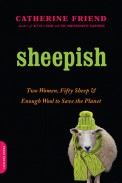Arts & Entertainment
A lovable wooly tale
Lesbian leaves city life behind to run sheep farm

When you had trouble with insomnia the other night, it seemed like nothing would lull you back to sleep. Warm milk tasted bad. That previously boring book on your bedside table suddenly turned intriguing. Even infomercials held your interest, so you started counting sheep.
Then you got to wondering — why sheep? Why not count cows or dogs? Is it because sheep are, well, like sheep? Author Catherine Friend wondered that herself because she has a flock of them on her Minnesota farm, and in her new book “Sheepish,” she writes of the good and the ba-a-a-ad, the wild and the wooly.
Though her grandmother raised them on a Montana ranch, Catherine Friend had little experience with sheep – that is, until her partner, Melissa, wistfully admitted her dream of owning a farm and raising the critters.
And thus it came to pass that Catherine had a little lamb.
Fifteen years later, Friend has morphed from City Girl to Backup Farmer. It hasn’t been a gentle-as-a-lamb transformation, but Friend now appreciates her flock.
Ovines have a long history in North America, she says. Sheep were shipped to the New World in 1609 and within 60 years, there were more than 100,000 sheep on our shores. English lawmakers tried to outlaw the sale of wool but colonists managed to outwit the Brits and wool gathering became patriotic.
Sheep “show up everywhere in our language,” Friend says, and they’re good for supper, of course, but it’s their wool that she fell in love with.
Because of the price of fleece, she says, many farmers shear their sheep and throw the wool away. Most small operations won’t get rich on their wool, but Friend discovered the rich colors of wool dyes. Although she first makes fun of “fiber freaks” (knitters who bleat rhapsodically about wool fibers), she couldn’t wait to see what “her sheep” produced.
But life on the farm isn’t always laid back. Where there’s livestock, “there’s dead stock,” says Friend. Animals, like humans, don’t always do what you want them to do; they’re never born at convenient times; and sometimes, they get sick. When these things happen, even Backup Farmers do their best for their animals – even if it means giving those animals up.
Imagine a serene pasture filled with contented (nameless) sheep. Then imagine a reluctant shepherdess at the helm, add llamas, cats and dogs, chickens and a peacock, frisky calves, knitters, and Elvis, and you’ve got a good yarn called “Sheepish.”
Author Catherine Friend gives her readers a sense of the bucolic. She lulls us into total serenity with her poetic descriptions of her flock and then she knocks us upside the funny bone with asides that are dyed-in-the-wool hilarious. In between, Friend has a way of bringing tears to our eyes before she pulls us back to the funny farm.
If a taste of the country is what you crave this summer, if you’re a farmer or a wannabe, a knitter, or just love a wooly tale, here’s a book you’ll enjoy. “Sheepish” is perfect for ewe.
‘Sheepish: Two Women, Fifty Sheep & Enough Wool to Save the Planet’
By Catherine Friend
$16
263 pages
Theater
Astounding ‘LIZZIE’ builds on legendary axe murder tale
Rock musical twist addresses abuse, oppression, queer identity

‘LIZZIE’
Through Nov. 30
Keegan Theatre
1742 Church St., N.W.
$54-$65
Keegantheatre.com
Lizzie Borden put Fall River, Mass., on the map. When the 32-year-old, seemingly respectable woman was charged with the axe murder of her father Andrew and stepmother Abby in the summer of 1892, it sent shock waves across the community and far beyond.
In time, the gruesome tale would weave its way into the annals of American crime lore, always remembered through that popular nursery rhyme “Lizzie Borden took an axe, gave her father 40 whacks…” Well, you know the rest.
The astoundingly terrific “LIZZIE” (now playing at Keegan Theatre, a short walk from Dupont Circle Metro) builds on the legend. The rock musical with book by Tim Maner, music by Steven Cheslik-deMeyer and Alan Stevens Hewitt, and lyrics by Cheslik-deMeyer and Maner, follows the days leading up to the grisly murders (unseen offstage) through Lizzie’s acquittal, bringing to the fore matters of abuse, oppression, and queer identity.
Shrewdly staged and choreographed by Jennifer J. Hopkins, the show begins with a haunting version of “Forty Whacks (Prologue),” featuring the talented cast of four women who can sing, act, move, and deliver the occasional laugh-out-loud line.
Clearly, frustrated Lizzie (powerfully played by Caroline Graham) and dominant older sister Emma (Sydne Lyon), both unmarried and still at home, are angsty and deeply unhappy. They resent their father for a litany of reasons including his extreme Yankee frugality. While one of the richest men in Fall River, he chooses to live on a sad street and go without indoor plumbing rather than set up housekeeping in posh digs across town. But it’s when they see Andrew’s great fortune slipping away to their stepmother that their fury reaches new heights.
Much of “LIZZIE” takes place at the scene of the crime, the Borden residence – cleverly suggested by scenic designer Josh Sticklin with some clapboard siding, stairways, a bit of period wallpaper and a purposely incongruous, large Borden family coat of arms.
Lighting designer Sage Green, convincingly and evocatively, summons at turns a bona fide rock concert experience, dimly lit parlor, or an intimate setting in a small yard.
And costume designer Logan Benson savvily adds to the atmosphere. Lizzie’s somber dresses with their accurate to the era leg-of-mutton sleeves give way to something altogether glitzier and more revealing after the murders.
There is dialogue, but the Riot Grrrl-inspired work is mostly sung through with punk rock anthems, ballads, and character driven songs. Whether spoken or sung, “LIZZIE” makes no bones about the title character’s guilt while introducing varying levels of collusion among the other women.
A knowing wry smirk from the house maid Bridget (Brigid Wallace Harper) says a lot about the family dynamic (“there’s a lock on every door / In every room a prisoner of a long, silent war”) as well as what went down that summer morning at the Borden house.
Lizzie’s secret girlfriend Alice (golden throated Savannah Blackwell) who conveniently lives next door, is besotted and watches her every move. Just after the murders, she saw Lizzie burn a dress in the yard.
The hard driving score is played by a passionate half-dozen strong band led by Marika Countouris. Sometimes, the instruments overpower the amplified singers and a lyric or two is lost, but that’s not so unusual with rock musicals.
At 90 minutes with a leisurely intermission (well-earned by the band and cast, especially Graham as Lizzie who’s onstage throughout, often incorporating frenetic movement and strenuous air guitar into her many songs), the first half explores feelings of entrapment and the second liberation.
Lizzie goes to trial. Despite a shaky alibi, the defendant seems to be winning over the jury. Looks like she might get that grand house on the hill after all.
The Borden story has been shared in varied ways including innumerable books and documentaries, Jack Beeson’s opera “Lizzie Borden” (1965), Agnes de Mille’s ballet “Fall River Legend” (1954), and the memorable 1975 TV movie starring Elizabeth Montgomery (best known as the perky reluctant witch Samantha Stevens on TV’s sitcom “Bewitched”) playing against type.
Today, the legend endures with “LIZZIE” at Keegan.
Movies
Superb direction, performances create a ‘Day’ to remember
A rich cinematic tapestry with deep observations about art, life, friendship

According to writer/director Ira Sachs, “Peter Hujar’s Day” is “a film about what it is to be an artist among artists in a city where no one was making any money.” At least, that’s what Sachs – an Indie filmmaker who has been exploring his identities as both a gay and Jewish man onscreen since his 1997 debut effort, “The Delta” – told IndieWire, with tongue no doubt firmly planted in cheek, in an interview last year.
Certainly, money is a concern in his latest effort – which re-enacts a 1974 interview between photographer Peter Hujar (Ben Whishaw) and writer Linda Rosenkrantz (Rebecca Hall), as part of an intended book documenting artists over a single 24-hour period in their lives – and is much on the mind of its titular character as he dutifully (and with meticulous detail) recounts the events of his previous day during the course of the movie. To say it is the whole point, though, is clearly an overstatement. Indeed, hearing discussions today of prices from 1974 – when the notion of paying more than $7 for Chinese takeout in New York City seemed outrageous – might almost be described as little more than comic relief.
Adapted from a real-life interview with Hujar, which Rosenkrantz published as a stand-alone piece in 2021 (her intended book had been abandoned) after a transcript was discovered in the late photographer’s archives, “Peter Hujar’s Day” inevitably delivers insights on its subject – a deeply influential figure in New York culture of the seventies and eighties, who would go on to document the scourge of AIDS until he died from it himself, in 1987. There’s no plot, really, except for the recalled narrative itself, which involves an early meeting with a French journalist (who is picking up Hujar’s images of model Lauren Hutton), an afternoon photo shoot with iconic queer “Beat Generation” poet/activist Allen Ginsburg, and an evening of mundane social interaction over the aforementioned Chinese food. Yet it’s through this formalized structure – the agreed-upon relation of a sequence of events, with the thoughts, observations, and reflections that come with them – that the true substance shines through.
In relaying his narrative, Hujar exhibits the kind of uncompromising – and slavishly precise – devotion to detail that also informed his work as a photographer; a mundane chronology of events reveals a universe of thought, perception, and philosophy of which most of us might be unaware while they were happening. Yet he and Rosenkrantz (at least in Sachs’ reconstruction of their conversation) are both artists who are keenly aware of such things; after all, it’s this glimpse of an “inner life,” of which we are rarely cognizant in the moment, that was/is their stock-in-trade. It’s the stuff we don’t think of while we’re living our lives: the associations, the judgments, the selective importance with which we assign each aspect of our experiences, that later become a window into our souls – if we take the opportunity to look through it. And while the revelations that come may occasionally paint them in a less-than-idealized light (especially Hujar, whose preoccupations with status, reputation, appearances, and yes, money, often emerge as he discusses the encounter with Ginsberg and his other interactions), they never feel like definitive interpretations of character; rather, they’re just fleeting moments among all the others, temporary reflections in the ever-ongoing evolution of a lifetime.
Needless to say, perhaps, “Peter Hujar’s Day” is not the kind of movie that will be a crowd-pleaser for everyone. Like Louis Malle’s equally acclaimed-and-notorious “My Dinner With Andre” from 1981, it’s essentially an action-free narrative comprised entirely of a conversation between two people; nothing really happens, per se, except for what we hear described in Hujar’s description of his day, and even that is more or less devoid of any real dramatic weight. But for those with the taste for such an intellectual exercise, it’s a rich and complex cinematic tapestry that rewards our patience with a trove of deep observations about art, life, and friendship – indeed, while its focus is ostensibly on Hujar’s “day,” the deep and intimate love between he and Rosenkrantz underscores everything that we see, arguably landing with a much deeper resonance than anything that is ever spoken out loud during the course of the film – and never permits our attention to flag for even a moment.
Shooting his movie in a deliberately self-referential style, Sachs weaves the cinematic process of recreating the interview into the recreation itself, bridging mediums and blurring lines of reality to create a filmed meditation that mirrors the inherent artifice of Rosenkrantz’s original concept, yet honors the material’s nearly slavish devotion to the mundane minutiae that makes up daily life, even for artists. This is especially true for both Hujar and Rosenkrantz, whose work hinges so directly to the experience of the moment – in photography, the entire end product is tied to the immediacy of a single, captured fragment of existence, and it is no less so for a writer attempting to create a portrait (of sorts) composed entirely of fleeting words and memories. Such intangibles can often feel remote or even superficial without further reflection, and the fact that Sachs is able to reveal a deeper world beyond that surface speaks volumes to his own abilities as an artist, which he deploys with a sure hand to turn a potentially stagnant 75 minutes of film into something hypnotic.
Of course, he could not accomplish that feat without his actors. Whishaw, who has proven his gifts and versatility in an array of film work including not only “art films” like this one but roles from the voice of Paddington Bear to “Q” in the Daniel Craig-led “James Bond” films, delivers a stunning performance, carrying at least 75% of the film’s dialogue with the same kind of casual, in-the-moment authenticity as one might expect at a dinner party with friends; and though Hall has less speaking to do, she makes up for it in sheer presence, lending a palpable sense of respect, love, and adoration to Rosenkrantz’s relationship with Hujar.
In fact, by the time the final credits role, it’s that relationship that arguably leaves the deepest impression on us; though these two people converse about the “hoi polloi” of New York, dropping legendary names and reminding us with every word of their importance in the interwoven cultural landscape – evoked with the casual air of everyday routine before it becomes cemented as history – of their era, it’s the tangible, intimate friendship they share that sticks with us, and ultimately feels more important than any of the rest of it. For all its trappings of artistic style, form, and retrospective cultural commentary, it’s this simple, deeply human element that seems to matter the most – and that’s why it all works, in the end. None of its insights or observations would land without that simple-but-crucial link to humanity.
Fortunately, its director and stars understand this perfectly, and that’s why “Peter Hujar’s Day” has an appeal that transcends its rarified portrait of time, place, and personality. It recognizes that it’s what can be read between the lines of our lives that matters, and that’s an insight that’s often lost in the whirlwind of our quotidian existence.
Out & About
Gala Hispanic Theatre’s Flamenco Festival returns

Gala Hispanic Theater will host the 21st Annual “Fuego Flamenco Festival” from Thursday, Nov. 6 to Saturday, Nov. 22.
The festival will feature American and international artists who will gather in the nation’s capital to celebrate the art of Flamenco. Guests can save 20% on tickets with a festival pass.
The festival kicks off now through Nov. 10 with the D.C. premiere of Crónica de un suceso, created, choreographed and performed by Rafael Ramírez from Spain, accompanied by renowned flamenco singers and musicians. In this new show, Ramírez pays homage to the iconic Spanish Flamenco artist Antonio Gades who paved the way for what Flamenco is today. GALA’s engagement is part of an eight-city tour of the U.S. by Ramírez and company.
The magic continues Nov. 14-16 with the re-staging of the masterpiece Enredo by Flamenco Aparicio Dance Company, a reflection of the dual nature of the human experience, individual and social, which premiered at GALA in 2023.
For more information, visit the theatre’s website.
-

 District of Columbia3 days ago
District of Columbia3 days ago‘Sandwich guy’ not guilty in assault case
-

 Sports3 days ago
Sports3 days agoGay speedskater racing toward a more inclusive future in sports
-

 Michigan5 days ago
Michigan5 days agoFBI thwarts Halloween terror plot targeting Mich. LGBTQ bars
-

 New Jersey4 days ago
New Jersey4 days agoBlue wave hits Northeast: Sherrill and Mamdani lead Democratic comeback














